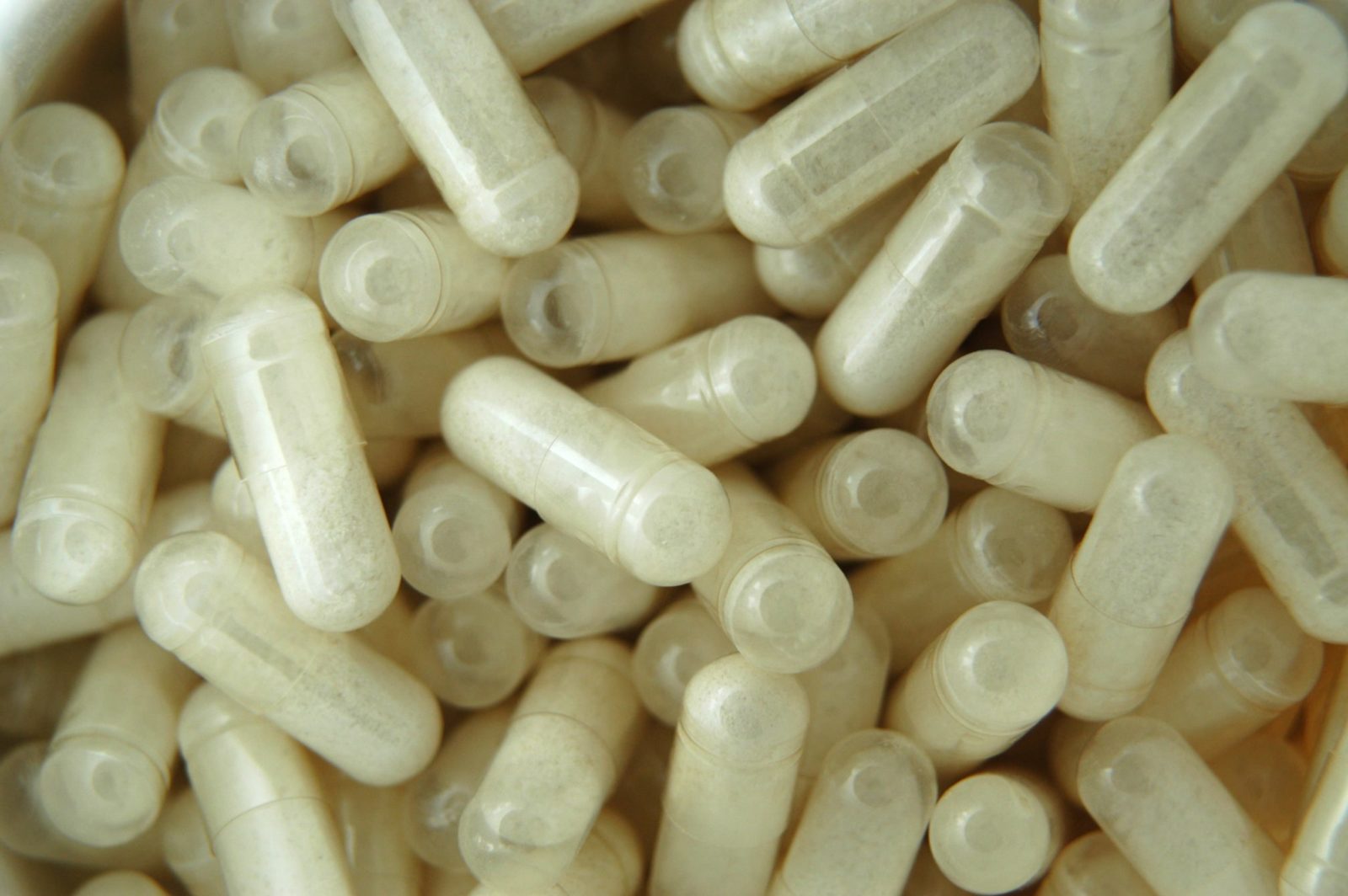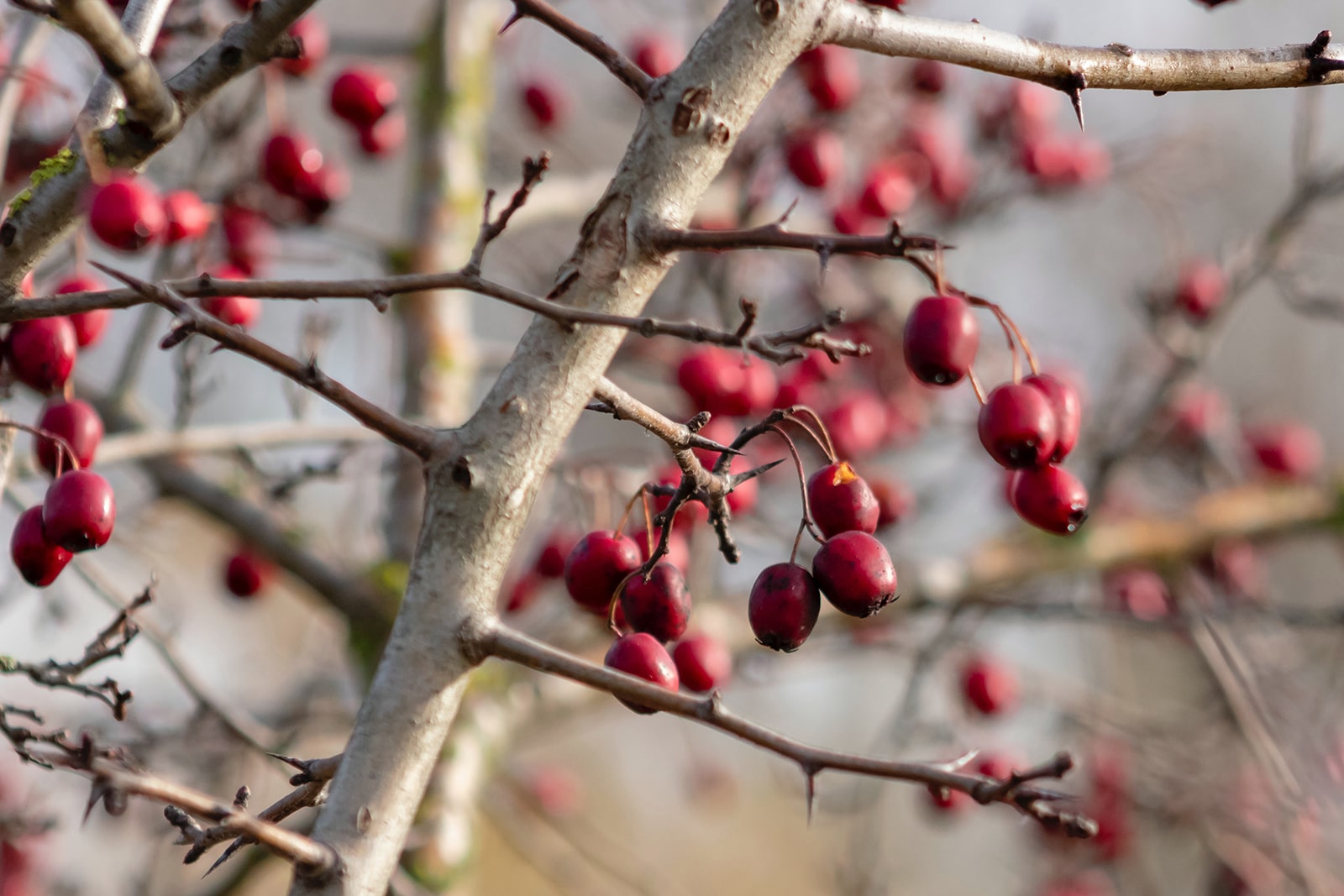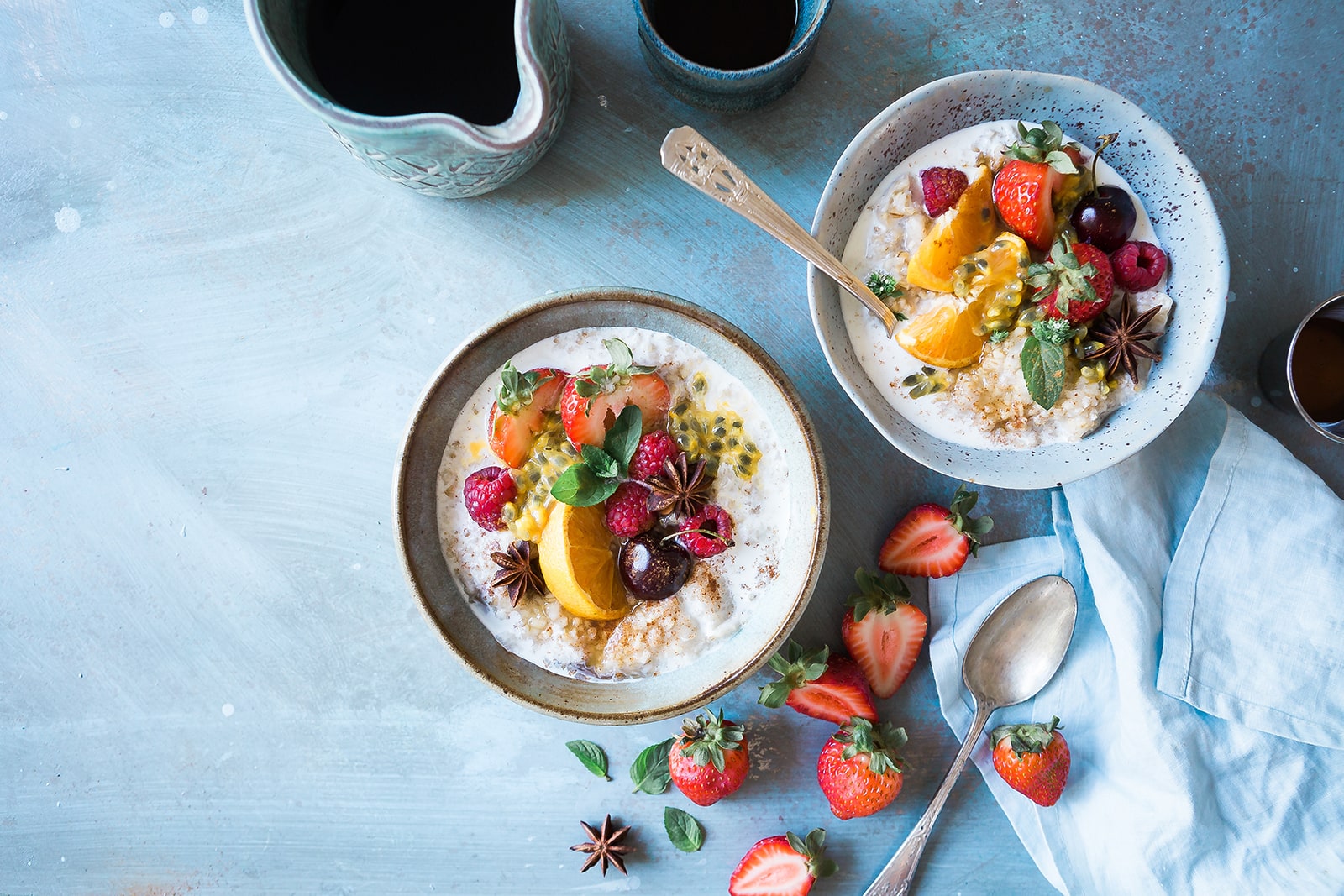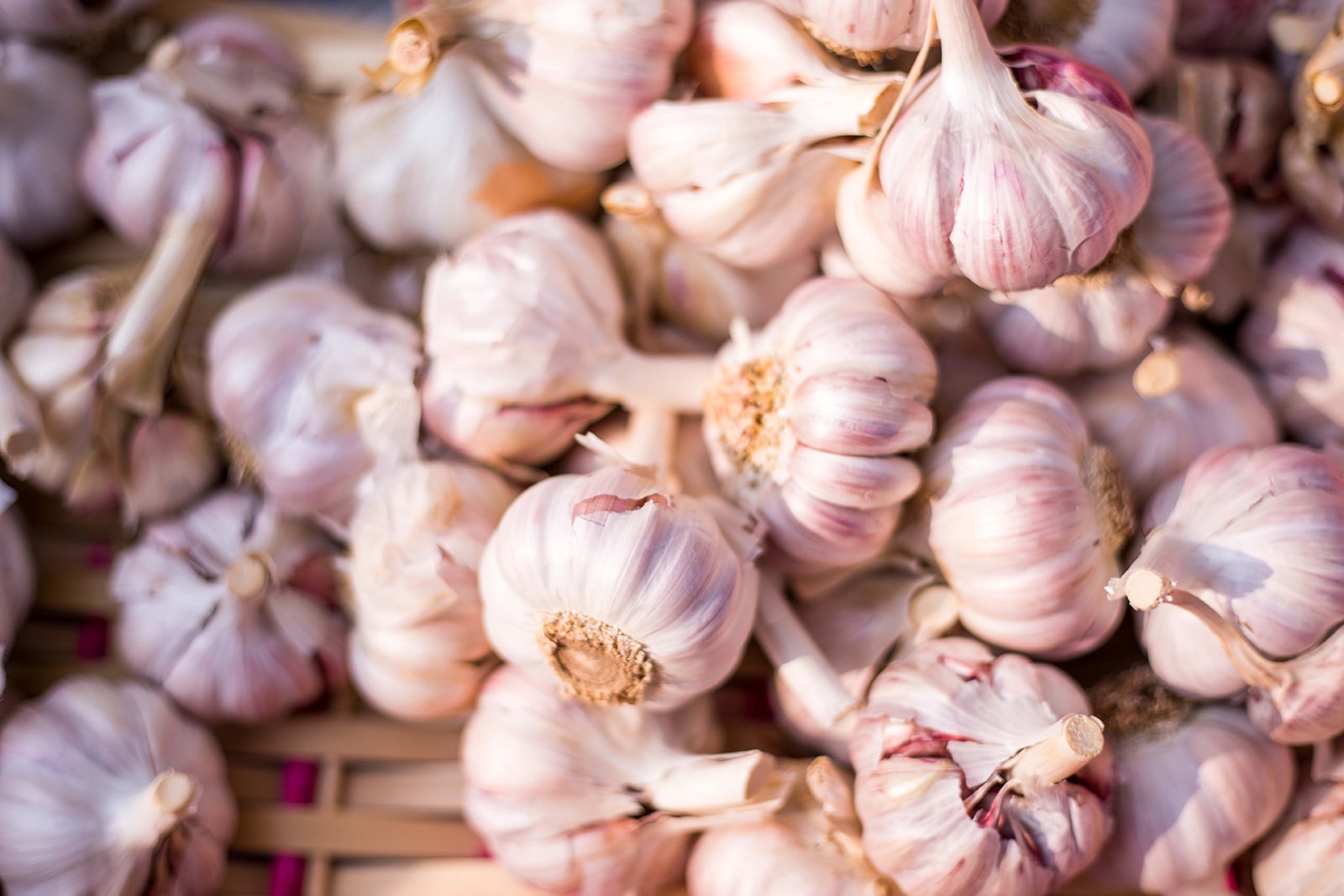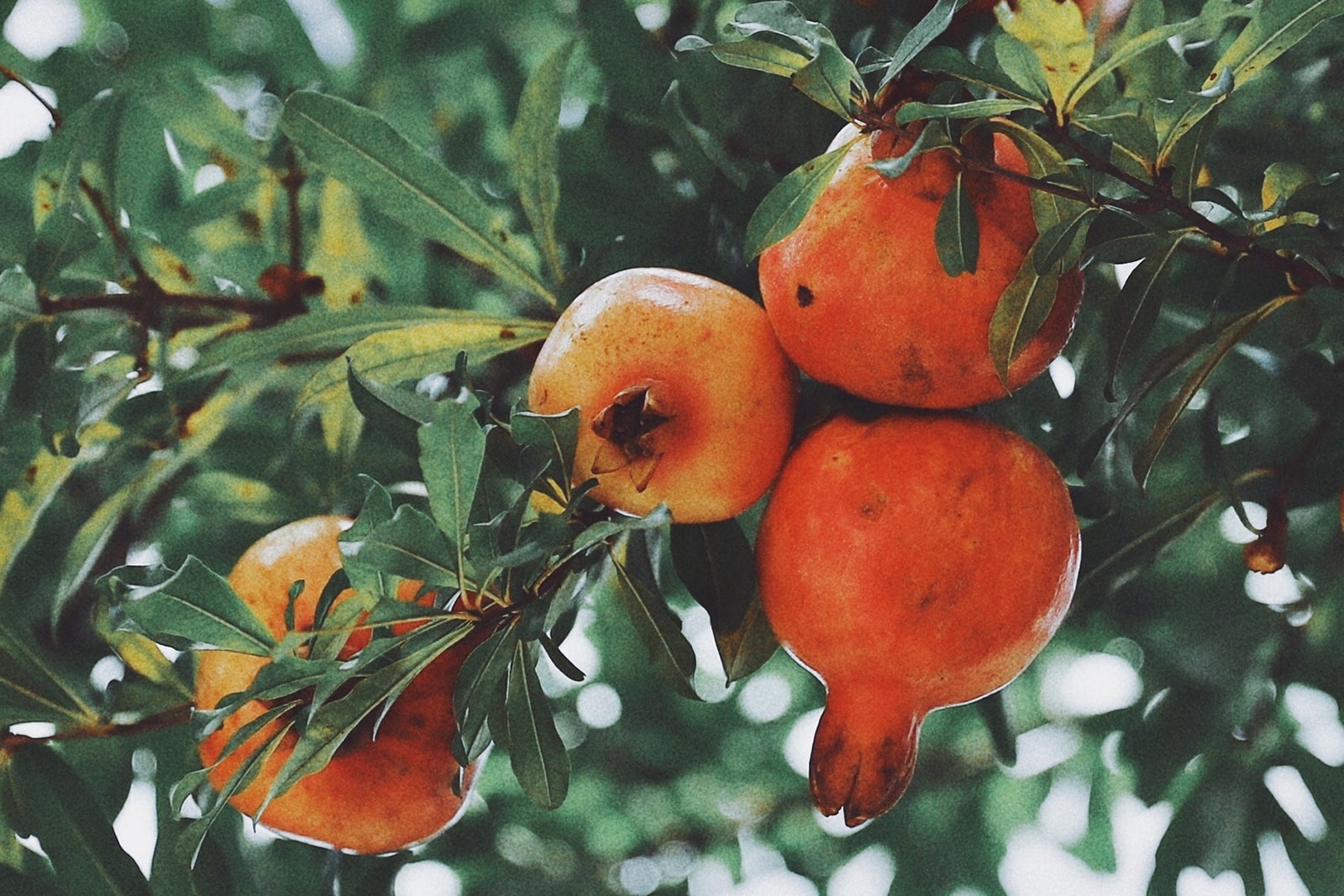The Ultimate Guide to a Maximizing Magnesium
The Ultimate Guide to a Maximizing Magnesium
Mineral balance plays a crucial role in promoting optimal health. Among these micronutrients, magnesium is arguably one of the most important. This is because magnesium's influence on various physiological functions underscores its significance, making it a cornerstone of nutrition and functional medicine. I wrote this to serve as comprehensive guide to leveraging magnesium to its full potential in all the roles it plays, including:
- Improve sleep
- Relieve anxiety
- Support energy production
- Benefit nerve function
- Relieve muscle cramps
- Support healthy blood sugar balance
- And improve cardiovascular health and blood pressure balance.
BTW a BIG thank you to Sara Gibbons MS for her help in editing and researching this blog @saragibbonsnutrition
Magnificent Magnesium
Magnesium serves as a vital micronutrient that participates in over 300 enzymatic reactions within the body. Dietary sources include leafy greens, nuts, seeds, whole grains, and legumes offer rich magnesium content.
Some Foods that contain good sources of magnesium include:
- Leafy green vegetables
- Nuts and seeds
- Whole grains
- Legumes (including tofu)
- Dark chocolate
The table below, has some examples of food sources of magnesium along with other benefits.
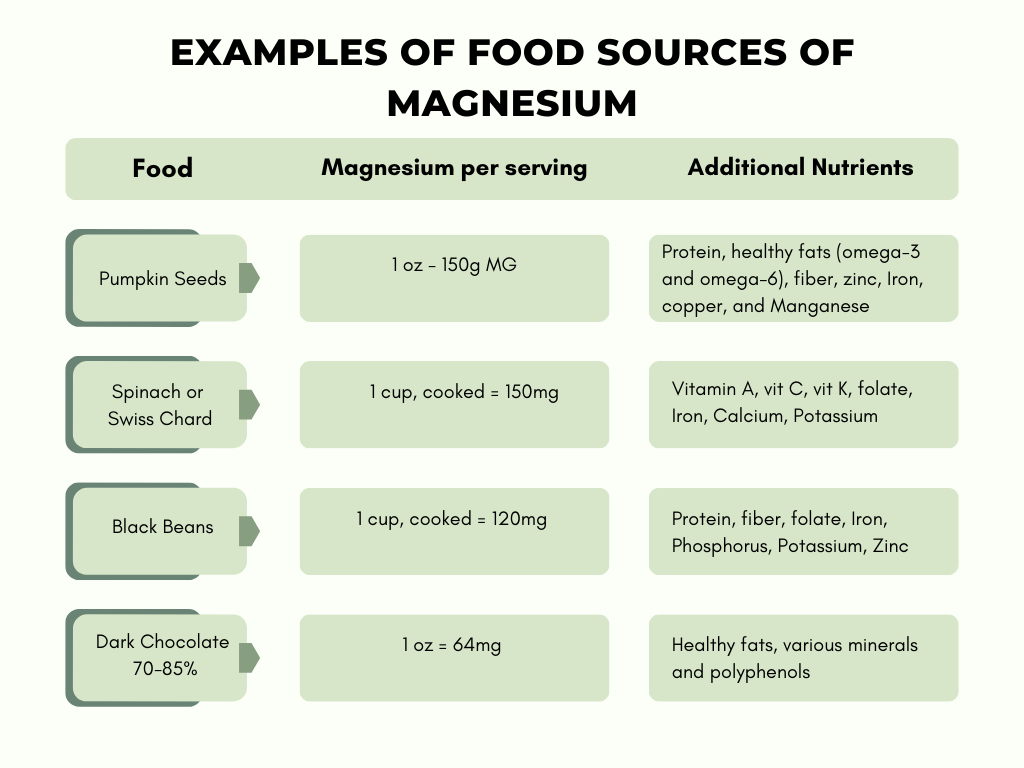
Absorption of magnesium can be inhibited by the presence of other nutrients, including phytates, oxalate, phosphate, proteins, potassium and zinc. That said, it typically takes considerably high doses of competing compounds to impact magnesium absorption rate.
Worth noting that cooking and typical processing of food during the food preparation process significantly reduces levels of phytates and oxalates. The microbiome plays an important role in determining the absorption rate of magnesium.
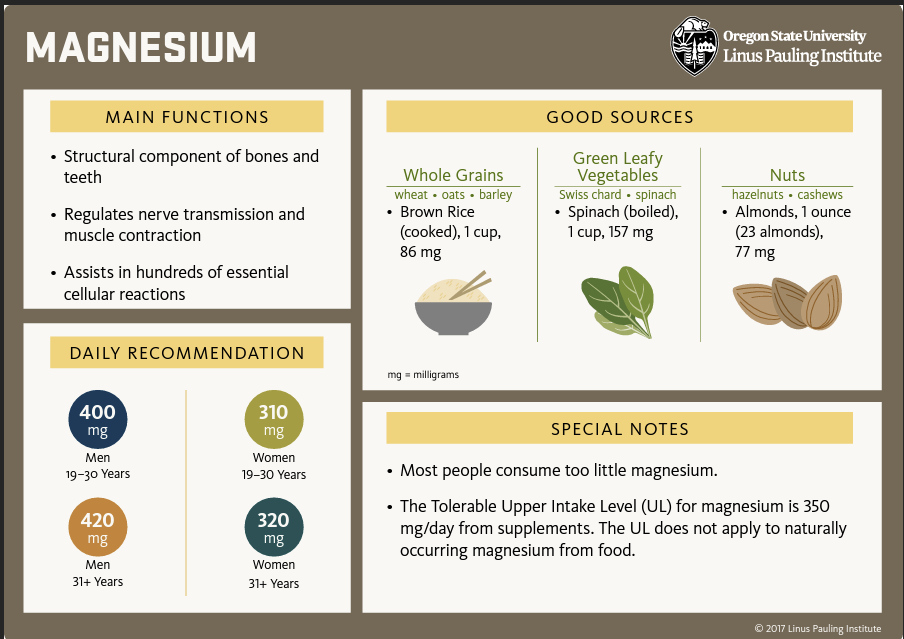
The Road to Optimizing Magnesium
To better understand how to personalize the clinical recommendations around magnesium optimization, let’s review all the factors that result in bioindividual variations.
Magnesium's Impact on Health
Magnesium exerts a profound influence on diverse aspects of health. Let’s dive into some of the ways that magnesium works in the body:
- Muscle and nerve function: regulating muscle contractions and nerve impulses.
- Bone health: contributing to bone density and strength.
- ATP synthesis: ensures a steady supply of energy for cellular processes.
- Helps produce glutathione: cofactor in facilitating the production of the “master antioxidant”
- Involved in RNA/DNA synthesis: Cell repair and regeneration
- Cardiovascular health: research has demonstrated its ability to contribute to healthy blood pressure levels and enhance overall cardiovascular function
- Blood sugar balance: Mg improves insulin sensitivity, which has implications for diabetes management
- Optimization of vitamin D: linked to improved CV health among other benefits, highlighting its interconnectedness with other nutrients.
- Helps alleviate anxiety: potent anxiolytic and promotes better sleep quality.
- Gastrointestinal motility: Mg citrate in particular makes for a great remedy for relieving constipation.
Magnesium Deficiency: Signs, Factors, and Risk
Because it’s in high demand and deficiency contributes to many side effects. Although abundant in both plant and animal foods, there are multiple factors related to modern lifestyle and dietary habits, as well as agricultural and food processing practices, that have contributed to insufficiencies of magnesium. These include:
- Stress: increases Mg demand including GI disorders, renal disease, cardiometabolic disease all increase physiological demand on magnesium
- DIND: Drug induced nutrient depletions
- Magnesium loss: Excess consumption of coffee/caffeine, alcohol, or sugary drinks
- Dietary intake: Reduced or insufficient intake from diet
- Digestive issues: dysbiosis and malabsorption
- Aging: associated with decreased GI absorption and increased urinary magnesium excretion therefore magnesium should be tracked closely in the elderly
Signs and symptoms of magnesium deficiency
Severe magnesium deficiency is relatively uncommon, but can be traced with serum magnesium levels and is associated with hypocalcemia (calcium deficiency, even despite adequate dietary calcium intake) which is associated with increased PTH secretion, mobilization of calcium from bone in an effort to normalize blood calcium concentration. If this persists it can lead to complications including osteopenia/osteoporosis, and vascular calcification and increased cardiovascular risks. Other symptoms present as neurological and muscular symptoms like tremor, muscle spasms, tetany, loss of appetite and nausea/vomiting.
More commonly seen in clinical practice are mild magnesium deficiencies which may be silent in terms of clinical symptoms, but instead have a more insidious effect as increased risk of developing chronic diseases. Chronic low magnesium state has been associated with a number of chronic diseases including diabetes, hypertension, coronary heart disease, and osteoporosis. Magnesium also plays a role in neurological drivers of mental health. Deficiencies of magnesium can increase oxidative stress and inflammation leading to neuro-inflammation which can manifest as depression or anxiety. Magnesium treatment is hypothesized to be effective as part of treatment in depression, anxiety, insomnia, and ADHD among other neurological conditions.
Optimizing magnesium to fit your personalized needs
The right amount of magnesium will vary based on various factors. To personalize your magnesium intake, we might consider periodic testing for red blood cell (RBC) magnesium levels. Let’s explore ways to maximize our magnesium below.
Magnesium and Lifestyle Medicine
Let’s first set a foundation that addresses lifestyle influences on magnesium levels. This starts with addressing components of diet, digestion, stress, sleep and movement.
- Starting with a foundational diet that includes magnesium-rich foods
- Supporting health digestion, by making sure we’re adopting habits that maximize digestive function and microbiome balance. This can include slowing down to chew, avoiding multitasking, and eating colorful foods, fibers, and fermented foods to help optimize microbiome balance and GI health.
- Since stress is a major contributor to magnesium depletion, adopting stress modification strategies can really help improve magnesium wasting. This strategy may also include setting basic goals for improving sleep and incorporating more movement.
- Magnesium plays an important role in inflammation and oxidative stress, reducing exposure to sources that deplete antioxidants can also be useful. This includes removing exposures to potential harmful chemicals and pesticides by filtering your water, swapping out your personal care products, and using air purifiers.
These four steps can help close the gap on magnesium need, and as we approach the optimal magnesium intake we experience the benefits of including enhanced exercise performance, muscle function, and post-exercise recovery, improved insulin sensitivity and more stable energy and mood.
Recommended Daily Intake vs Bioindividual Magnesium Needs
The recommended daily allowance (RDA) of magnesium varies based on factors such as age, gender, and life stage. Generally, adult men are advised to consume around 400-420 mg per day, while women are recommended to intake approximately 310-320 mg. During pregnancy and lactation, these requirements may differ.
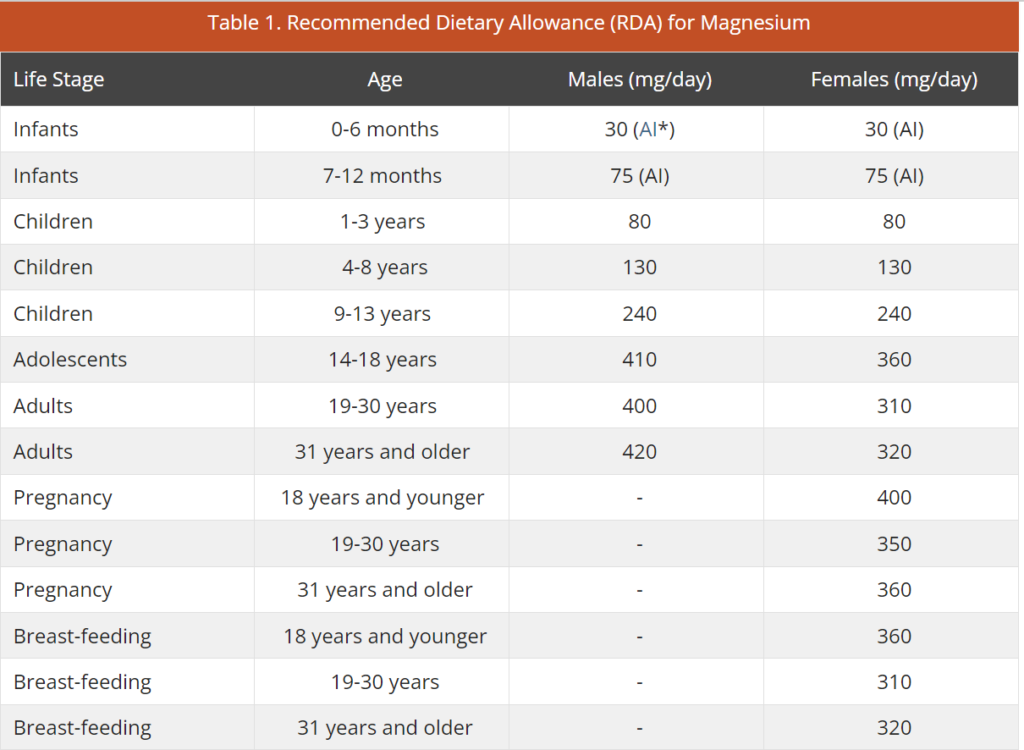
Choosing the Right Magnesium Supplement
Tailoring magnesium intake according to specific requirements optimizes its therapeutic potential. Plus, when considering supplementation, different forms of magnesium exhibit varying benefits.
There are a few different options, the form you choose depends on what you're using it for:
- For anxiety or insomnia, glycinate seems to work best in my experience. Magnesium Glycinate can also be a great choice if you’re not sure where to start. The glycinate (or bisglycinate) form has great absorption. Plus, glycine is an amino acid with natural relaxing activity. Making this combo a great option for anxiety and insomnia without excess sedation.
- My constipation go-to is Magnesium Citrate. If you tend towards hard stools in particular, magnesium citrate has good local activity but less extensive systemic activity - making it perfect to work locally in the GI to help with motility and bowel movement.
- Threonate has the most studies for neurological benefits Magtein is the specific ingredient to look for because it’s derived from magnesium threonate. This form of magnesium crosses the blood-brain barrier and makes it more readily available in the brain. Some studies suggest that this form is especially useful for cognitive function - including improved attention, learning, and memory.
- When I need a “Jack of All Trades” - a basic formulation to get your magnesium levels up so it needs great systemic absorption AND support bowel motility. A combination product is my go to for general cardiovascular, blood sugar balancing and metabolic support. I opt for a combination product of citrate, glycinate, and I usually avoid oxide.
Find my magnesium protocol picks on Fullscript HERE.
Screening for Magnesium needs
Serum magnesium isn’t an effective way to track magnesium levels because it is too tightly bound to renal activity and tightly controlled to protect us from severe magnesium depletion. Instead, a red blood cell (RBC) magnesium level is preferred. An RBC magnesium reference range typically between 4.2 and 6.8 mg/dL. However, I generally aim for the top 5th of the range, a minimum level of 6.0 mg/dL.
I also couple that with an organic acid evaluation which helps to better understand the various metabolites from magnesium and related nutrients to evaluate magnesium need based on physiological demand.
Conclusion: And a note to clinicians
Recognizing magnesium's therapeutic potential within preventing and managing chronic disease and related symptoms that contribute to quality of life is a critical component of lifestyle medicine. Because it’s such a low hanging fruit in terms of therapeutic benefits, dietary sources, and supplement access, it can be an easy first step to nutrition implementation into any practice.
I encourage you to consider the integration of magnesium education into patient care and wellness programs. This collaborative approach ensures a comprehensive approach to health promotion.
Clinicians: Join me on Fullscript
Fullscript is a digital health platform that helps practitioners build better patient relationships through quality supplementation and intuitive tools for treatment adherence — all at no cost. Beyond supplement planning, Fullscript delivers evidence-based resources, ready-made protocols, personalized refill reminders, and more to help sustain optimal health over time.
Practitioners write online supplement plans or dispense supplements in-office, giving patients easy access to high-quality products and education for optimal health. Physicians and other healthcare practitioners can join Fullscript HERE for free.
References
- Linus Pauling Institute. https://lpi.oregonstate.edu/mic/minerals/magnesium
- Swaminathan R. Magnesium metabolism and its disorders. Clin Biochem Rev. 2003;24(2):47-66. https://www.ncbi.nlm.nih.gov/pmc/articles/PMC1855626/
- Ates, M., Kizildag, S., Yuksel, O. et al. Dose-Dependent Absorption Profile of Different Magnesium Compounds. Biol Trace Elem Res 192, 244–251 (2019). https://doi.org/10.1007/s12011-019-01663-0 .
- Piuri G, Zocchi M, Della Porta M, et al. Magnesium in Obesity, Metabolic Syndrome, and Type 2 Diabetes. Nutrients. 2021;13(2):320. Published 2021 Jan 22. doi:10.3390/nu13020320. https://pubmed.ncbi.nlm.nih.gov/33499378/
- Fiorentini D, Cappadone C, Farruggia G, Prata C. Magnesium: Biochemistry, Nutrition, Detection, and Social Impact of Diseases Linked to Its Deficiency. Nutrients. 2021;13(4):1136. Published 2021 Mar 30. doi:10.3390/nu13041136. https://pubmed.ncbi.nlm.nih.gov/33808247/
- Schiopu C, Ștefănescu G, Diaconescu S, et al. Magnesium Orotate and the Microbiome-Gut-Brain Axis Modulation: New Approaches in Psychological Comorbidities of Gastrointestinal Functional Disorders. Nutrients. 2022;14(8):1567. Published 2022 Apr 9. doi:10.3390/nu14081567. https://pubmed.ncbi.nlm.nih.gov/35458129/
- Noah L, Dye L, Bois De Fer B, Mazur A, Pickering G, Pouteau E. Effect of magnesium and vitamin B6 supplementation on mental health and quality of life in stressed healthy adults: Post-hoc analysis of a randomised controlled trial. Stress Health. 2021;37(5):1000-1009. doi:10.1002/smi.3051. https://pubmed.ncbi.nlm.nih.gov/33864354/
- Rajizadeh A, Mozaffari-Khosravi H, Yassini-Ardakani M, Dehghani A. Effect of magnesium supplementation on depression status in depressed patients with magnesium deficiency: A randomized, double-blind, placebo-controlled trial. Nutrition. 2017;35:56-60. doi:10.1016/j.nut.2016.10.014. https://pubmed.ncbi.nlm.nih.gov/28241991/
- Boyle NB, Lawton C, Dye L. The Effects of Magnesium Supplementation on Subjective Anxiety and Stress-A Systematic Review. Nutrients. 2017;9(5):429. Published 2017 Apr 26. doi:10.3390/nu9050429. https://pubmed.ncbi.nlm.nih.gov/28445426/
- Aucoin M, LaChance L, Naidoo U, et al. Diet and Anxiety: A Scoping Review. Nutrients. 2021;13(12):4418. Published 2021 Dec 10. doi:10.3390/nu13124418. https://pubmed.ncbi.nlm.nih.gov/34959972/
- Gröber U, Schmidt J, Kisters K. Magnesium in Prevention and Therapy. Nutrients. 2015;7(9):8199-8226. Published 2015 Sep 23. doi:10.3390/nu7095388. https://pubmed.ncbi.nlm.nih.gov/26404370/
- Maier JAM, Locatelli L, Fedele G, Cazzaniga A, Mazur A. Magnesium and the Brain: A Focus on Neuroinflammation and Neurodegeneration. Int J Mol Sci. 2022;24(1):223. Published 2022 Dec 23. doi:10.3390/ijms24010223. https://www.ncbi.nlm.nih.gov/pmc/articles/PMC9820677/
- Botturi A, Ciappolino V, Delvecchio G, Boscutti A, Viscardi B, Brambilla P. The Role and the Effect of Magnesium in Mental Disorders: A Systematic Review. Nutrients. 2020;12(6):1661. Published 2020 Jun 3. doi:10.3390/nu12061661. https://www.ncbi.nlm.nih.gov/pmc/articles/PMC7352515/
- Zhang C, Hu Q, Li S, et al. A Magtein®, Magnesium L-Threonate, -Based Formula Improves Brain Cognitive Functions in Healthy Chinese Adults. Nutrients. 2022;14(24):5235. Published 2022 Dec 8. doi:10.3390/nu14245235. https://www.ncbi.nlm.nih.gov/pmc/articles/PMC9786204/
Make New Year's Resolutions Stick!
New Year’s allows us a time to reboot … it’s life’s do-over button.
Make New Year’s Resolutions Stick
It’s that time of year, the age-old tradition of making New Year’s resolutions. I personally love this tradition. To me it’s a time to look ahead and decide who I want to be in the upcoming year and what I want to accomplish. It’s also an exercise in introspection, narrowing down what defines us, our priorities and what will help us be content and happy.
We all start out strong, resolve to do this or that- lose weight, budget better, get organized- but for many of us it’s long forgotten by March.
How do we make New Year’s resolutions stick? Why do you find yourself repeating the same resolution over and over, year in, year out?
Because instead of declarations, to make big life changes, we need an action plan, guidance and most of all support!
Keep reading for a step-by-step approach for New Year’s resolution goal-setting and a free journal template you can have emailed right to you, get started, click here.
How about this year we approach our resolutions a little differently? Instead of grand resolutions, set 3-5 priorities to focus on (career? Friends? family?). Next, identify actionable goals for each category. Third, what are the steps needed to take to get there? And finally, what are some setbacks you might anticipate?
Plan your action steps
- Identify your priorities
- For each priority, define your goals. The more specific the better.
- Outline, step-by-step, what you need to do to reach that goal.
- Brainstorm a few obstacles you anticipate may derail you.
- What tools can you use to keep accountable?
Want to make time for meditation and mental health? Schedule time in your day, find an app like Headspace that can help you, and set reminders to make it a habit.
Want to spend more quality time with your family? Take a hard look at your schedule for 2017 and ask yourself how you can manage your work schedule to be more available to them. Maybe that means shutting down your laptop at 7 pm sharp. Or maybe consider setting an automatic email responder to let clients know you’re unavailable on the weekend. Or it means planning quarterly getaways and getting scheduling work trips in advance around those.
Or perhaps, like most of us, you’d like 2017 to be the year you get in great shape. But before you write down “I want to lose weight,” or “I’m going to get in shape,” define exactly what that means to you.
Do you have a health condition you need to tackle? Or maybe you need to focus on weight loss around your midsection. Then follow through the steps: what has been slowing you down? Crazy schedule? Or maybe you don’t feel confident about your cooking skills. Whatever the block is, find a solution – schedule non-negotiable time for your workouts in advance or subscribe to a meal service or take some cooking classes.
Above all you’ll want to hold yourself accountable in some way. I’ve always found the buddy system to be the most effective. A friend or relative that’s invested in seeing you succeed can help keep you on track and check-in periodically, help you troubleshoot ways to get past areas of resistance.
You know what’s even more effective? Hire a coach to help you get there. The most successful people are those who identify the areas they need professional help with and invest in the support they need to succeed.
It’s not too late to make this your best year ever! Download your journal template.
January is a perfect time to take inventory and start to assess what you want the rest of your year to look like. Though, honestly, this is a good exercise to try any time of year.
Give it a try – get your favorite journal out or get the free journal worksheet template sent to your inbox, click here. I’ve put together questions to help get you started and guide you through the process.
Nutrition and Lifestyle for Heart Health
According to the American Heart Association (AHA), cardiovascular disease is the number one cause of mortality worldwide – responsible for 17 million deaths last year, it’s expected to rise by another 6 million by the year 2030.
Those are staggering statistics, but don’t let the numbers scare you… a little education can go a long way in learning how to minimize your risks and improve your heart health, naturally.
The heart is the center of our cardiovascular system and beats an average of 100,000 times per day supplying oxygen rich blood to the whole body. Every day we make choices that have a profound effect on the health of this vital organ. Most cardiovascular or heart disease (CVD or HD) maybe linked to lifestyle risk factors such as lack of exercise, obesity, smoking, stress, and poor eating habits. Though there is a genetic component that might also play a hand.
The Silent Killer
One of the most common risk factors of CVD is elevated blood pressure or hypertension (HTN). Often called the ‘silent killer’, hypertension can cause significant damage throughout the cardiovascular and other body systems and ultimately results in over 80 million deaths each year.
Blood pressure is the amount of pressure exerted on the inside of blood vessels as the heart pumps the blood through the body. When there is resistance in the vessels, the pressure rises and hypertension results. The longer hypertension goes undetected and/or uncontrolled, the greater the damage to blood vessels and other organs. Hypertension can lead to heart attack, stroke, ruptured blood vessels, kidney disease or failure, and heart failure.
Warning signs for high blood pressure are rare (hence the name “Silent killer”) but can include headaches, blurred vision, lightheadedness, shortness of breath and nosebleeds.
Know Your Numbers
Hypertension is diagnosed by analyzing the 2 numbers in your BP reading:
- Systolic pressure (the top number) is the pressure in your arteries when the heart beats (contracts).
- Diastolic pressure (bottom number or think D for “Down”) represents the pressure in your arteries between beats.
Normal blood pressure is below 120/80
Prehypertension is 120 – 139 systolic or 80 – 89 diastolic.
Hypertension is 140/90 or higher
It’s also good to note that HTN is a risk factor for metabolic syndrome (or pre-diabetes) along with 4 other factors that include abdominal weight gain, elevated Triglycerides, and low HDL (that’s the good cholesterol).
The Potassium* Secret for Heart Healthy
You’ve no doubt heard the best thing to do when you have hypertension is to reduce the amount of salt/sodium in your diet. Did you know the average adult needs 4,700 mg of potassium daily compared to only 200 mg of sodium. Unfortunately for most of us, our eating habits give us way too much sodium – 3,300 mg a day – and not nearly enough potassium. This imbalance can increase your risk of developing hypertension.
What’s truly important for your heart, and a more accurate strategy to prevent high blood pressure, is to balance the relationship between potassium and sodium (salt) in your daily diet. Proper sodium-potassium balance is necessary for nerve transmission, muscle contraction, fluid balance, and the optimal health of all the cells in your body. In regard to the heart, potassium is particularly important for regulating heart rhythm and maintaining blood pressure.
By reducing your sodium intake, you are often correcting the sodium-potassium imbalance without realizing it. For the best benefit to heart health, eat more potassium-rich foods such as sweet potato, spinach, banana, peas, legumes, apricots, avocados, halibut and molasses*.
5 Heart Heart Health Tips
- Heart-healthy diet do’s: Eat a variety of fresh fruits and dark green veggies daily. Use plant-based oils for cooking. Eat mindfully, not on-the-run. Reduce or eliminate packaged foods, sugar, and red meat.
- Exercise: Walk, no need to run- as little as 30 minutes of daily, brisk walking lowers your risk for hypertension.
- Spend less time sitting: In a recent study, those who logged in more than 4 hours of screen time where at 125% higher risk of cardiovascular disease. Invest in a standing desk, take frequent moving breaks throughout the day, track your daily steps, or use a balance ball to sit instead of a chair.
- Learn to manage stress: Using healthy coping techniques, such as, deep breathing, yoga, meditation, gratitude journaling, and getting quality sleep.
- Supplemental support: Nutritional supplements** shown to support heart health include Hawthorn, CoQ10, Essential Fatty Acids, Magnesium, Garlic and B-vitamins. There’s heaps of research to support the use of these supplements and herbs effectively. Talk with your healthcare provider or nutritionist to learn what would be best for you.
*Because some blood pressure medications affect the potassium level in the body, be sure and discuss the best strategy for making this adjustment with your doctor.
**Supplements you might have heard about—Natto-K (nattokinase), Guggul, or Niacin—should not be taken without the supervision of your health practitioner.
Resources
- Murray, M. “Hypertension” as cited in Pizzorno, Joseph E. (2013). Textbook of Natural Medicine. St. Louis, MO Elsevier. (chapter 174), 1475-1485.
- Johnson, R.L., S. Foster, Low Dog, T. and Kiefer, D. “Plants and the Heart” in National Geographic Guide to Medicinal Herbs: The World’s Most Effective Healing Plants. Washington, D.C.: National Geographic, 2012. 100-101.
- Centers for Disease Control and Prevention, National Center for Health Statistics. Underlying Cause of Death 1999-2013 on CDC WONDER Online Database, released 2015. Data are from the Multiple Cause of Death Files, 1999-2013, through the Vital Statistics Cooperative Program. Accessed on December 11, 2015.: http://wonder.cdc.gov/ucd-icd10.html
- Mayo Clinic. “High Blood Pressure- Hypertension.” Updated November 10, 2015. http://www.mayoclinic.org/diseases-conditions/high-blood-pressure/basics/definition/con-20019580
- National Heart, Lung & Blood Institute. “Risk Factors for High Blood Pressure.” Updated September 2015. http://www.nhlbi.nih.gov/health/health-topics/topics/hbp/atrisk
- Lelong, H., Galan, P. et al., “Relationship Between Nutrition and Blood Pressure: A Cross-Sectional Analysis from the NutriNet-Santé Study, a French Web-based Cohort Study” Am J Hypertens first published online September 3, 2014 doi:10.1093/ajh/hpu164. Accessed on Dec 21, 2015: http://ajh.oxfordjournals.org/content/early/2014/09/03/ajh.hpu164
- Study above cited in Time magazine article, accessed on Dec 21, 2015: http://time.com/3313332/salt-and-blood-pressure/
- Appel, L.J., Brands, M.W., et al., American Heart Association. “Scientific Statement: Dietary Approaches to Prevent and Treat Hypertension.” Updated January 2014. http://dx.doi.org/10.1161/01.HYP.0000202568.01167.B6
- American Heart Association. “Learn more about heart disease and high blood pressure.” Accessed on December 11, 2015. http://www.heart.org/HEARTORG/Conditions/HighBloodPressure/High-Blood-Pressure-or-Hypertension_UCM_002020_SubHomePage.jsp
- American Heart Association. “Walk, Don’t Run Your Way to a Healthy Heart.” Accessed on December 11, 2015. http://www.heart.org/HEARTORG/GettingHealthy/PhysicalActivity/Walking/Walk-Dont-Run-Your-Way-to-a-Healthy-Heart_UCM_452926_Article.jsp#.Vop0pDYwcrg
- http://www.heart.org/HEARTORG/Conditions/Conditions_UCM_001087_SubHomePage.jsp
- American Heart Association. “Walking Can Lower Risk of Heart Related Conditions” Accessed on December 11, 2015.http://newsroom.heart.org/news/walking-can-lower-risk-of-heart-related-conditions-as-much-as-running
- American Heart Association. “Potassium and high blood pressure.” Last Updated August 04, 2014. Accessed on December 11, 2015. http://www.heart.org/HEARTORG/Conditions/HighBloodPressure/PreventionTreatmentofHighBloodPressure/Potassium-and-High-Blood-Pressure_UCM_303243_Article.jsp#.Vopz2DYwcrg
- Harvard School of Public Health. “Shifting the Balance of Sodium and Potassium in Your Diet.” Accessed on December 11, 2015. http://www.hsph.harvard.edu/nutritionsource/sodium-potassium-balance/
- Linus Pauling Institute: Micronutrient Information Center. “Sodium (Chloride).” Last Reviewed 2008. Accessed on December 11, 2015. http://lpi.oregonstate.edu/mic/minerals/sodium
- Linus Pauling Institute: Micronutrient Information Center. “Potassium.” Last Reviewed 2010. Accessed on December 11, 2015. http://lpi.oregonstate.edu/mic/minerals/potassium
- Saba, Magdi M. et al., “Concepts of the Heart in Ancient Egypt” Med Sci. (Paris). 20, no.3 (March 2004): 367 – 373. http://dx.doi.org/10.1051/medsci/2004203367
- Levine, J. A., M.D., Ph.D. (2015, September 04). What are the risks of sitting too much? Retrieved February 10, 2016, from http://www.mayoclinic.org/healthy-lifestyle/adult-health/expert-answers/sitting/faq-20058005
Hawthorn Berry (Crataegus oxyacantha)
Hawthorn Berry (Crataegus oxyacantha)
Hawthorn berry Crataegus oxyacantha (Latin binomial), sometimes called Maybush, is a thorny shrub found that can be found growing on hillsides and in sunlit woodsey areas throughout the world. It’s been used for centuries to prepare foods, beverages, and medicines.
In folk medicine, Hawthorn was used for the treatment of diarrhea, insomnia, and asthma. In China, it has been used to treat digestive problems, high cholesterol, poor circulation, and shortness of breath. During the early 1800’s, doctors in North America used Hawthorn to treat heart conditions, circulatory, and respiratory disorders.
Hawthorn has a rich supply of flavonoids (antioxidants that protect cells from damage) and anti-inflammatory properties, which are important to heart health. It plays a role in helping dilate blood vessels, improves blood flow to the heart, and lowers blood pressure. In fat, in Europe Hawthorn is regarded as a safe and effective treatment for early-stage heart disease. It is used to promote the health of the circulatory system and to treat angina, high blood pressure, and congestive heart failure. In studies, patients with heart failure who took Hawthorn showed improvement in clinical symptoms and sense of well-being.
Hawthorn berry is available as tea, capsule, tincture, and standardized extract found in prescription drugs (not in the US), over-the-counter medication, standardized herbal medicine, or dietary supplements. Before taking Hawthorn, especially if you suspect or have a heart or lung condition, consult with a holistic integrative health practitioner.
Resources
- Hawthorn. Complementary and Alternative Medicine Guide. University of Maryland Medical Center Online. https://umm.edu/health/medical/altmed/herb/hawthorn
- Johnson, Rebecca L. & Foster, Steven et al., National Geographic Guide to Medicinal Herbs: The World’s Most Effective Healing Plants. (National Geographic Society. (2010, 2014), 123-125.
- Hawthorn Berry (Crateagus Oxycanthus): Health Benefits. http://www.herbwisdom.com/herb-hawthorn-berry.html
- Mars, Bridgitte & Fiedler, Chrystle. Home Reference Guide to Holistic Health & Healing. (Beverly, MA: Fair Winds Press. 2015.), 189.
- Dahmer, S., Scott, E. “Health Effects of Hawthorne,” Amer Family Phys. (Feb 15, 2010) 81:4, 465-468. Accessed: Dec. 09, 2015: http://www.aafp.org/afp/2010/0215/p465.html
- Chang, W., Dao, J., and Shao, Z. “Hawthorn: Potential Roles in Cardiovascular Disease.” American Jnl. Chinese Medicine (January 2005) 33:01, pp. 1-10. DOI: 10.1142/S0192415X05002606. http://www.worldscientific.com/doi/abs/10.1142/S0192415X05002606?url_ver=Z39.88-2003&rfr_id=ori%3Arid%3Acrossref.org&rfr_dat=cr_pub%3Dpubmed&
- ie Wang, Xingjiang Xiong, and Bo Feng, “Effect of Crataegus Usage in Cardiovascular Disease Prevention: An Evidence-Based Approach,” Evidence-Based Complementary and Alternative Medicine, vol. 2013, Article ID 149363, 16 pages, 2013. doi:10.1155/2013/149363. http://www.hindawi.com/journals/ecam/2013/149363/
Sage (Salvia officinalis)
Sage (Salvia officinalis)
Clear Your Mind with Sage.
Sage, with its woody stems, grayish leaves, and lovely purplish-blue flowers, is a native perennial of the Northern Mediterranean coast and an herbal member of the mint family. If you’re only familiar with Sage for seasoning savory dishes, you’re missing out on a fascinating botanical remedy.
Ancient Greeks and Romans burned sage in ceremonies, believing it would impart wisdom. Early European herbalists used Sage to clear congestion, purify the blood, and cleanse the teeth. In Native American and indigenous cultures around the world, shamans use White Sage to cleanse both persons and spaces of evil influences. Priests still burn Sage in religious ceremonies. Even though it has not been proven that Sage will raise your consciousness, many people burn Sage to facilitate relaxation during yoga or meditation.
Today, we know that Sage leaves and flowers contain chemicals with antibacterial, astringent, and antiseptic properties. At your local holistic market, you can find Sage in a variety of products. It is used in natural deodorant, and in mouthwash because it fights bacteria responsible for gum disease. In herbal remedies, a sage tea or tincture can help ease sore throat, congestion, digestive cramping, and support mental wellness. In aromatherapy preparations, sage is most often used as an essential oil in an air diffuser or in candles. Dried White Sage is most commonly burned (known as smudging) as incense with the intention to clear the lungs, ease mental stress, and enhance mood.
Using Sage as a botanical remedy is very different from cooking with the herb. Medicinal preparations and essential oils derived from Sage contain thujones, a naturally occurring chemical in the plant. If you take a higher dose of medicinal Sage than is recommended, it could cause serious health problems such as tremors, rapid heart rate, vertigo and vomiting. Consult your holistic health practitioner for guidance on the safe use of any Sage remedy.
Looking for tips on getting a more restful sleep?
Resources
Mars, Bridgitte & Fiedler, Chrystle. Home Reference Guide to Holistic Health & Healing. (Beverly, MA: Fair Winds Press. 2015.), 30, 143, 203.
Johnson, Rebecca L. & Foster, Steven et al., National Geographic Guide to Medicinal Herbs: The World’s Most Effective Healing Plants.(National Geographic Society. 2010, 2014.), 90-93
Sage: Herb Wisdom.com http://www.herbwisdom.com/herb-sage.html
National Centers for Complementary and Integrative Health Info Sheet: Sage:https://nccih.nih.gov/health/sage
Smudging with Sage: http://www.mindbodygreen.com/0-17875/a-sage-smudging-ritual-to-cleanse-your-aura-clear-your-space.html
Walch SG, Kuballa T, Stühlinger W, Lachenmeier DW. “Determination of the biologically active flavour substances thujone and camphor in foods and medicines containing sage (Salvia officinalis L.)”.
Chem Cent J. (Jul 21, 2011): 5-44. http://www.ncbi.nlm.nih.gov/pmc/articles/PMC3155476/
Kennedy, D. O., Wightman, E. L. “Herbal Extracts and Phytochemicals: Plant Secondary Metabolites and the Enhancement of Human Brain Function.” Advances in Nutrition: An International Review Journal. (11 January 2011): 2(1), 32–50. https://www.ncbi.nlm.nih.gov/pmc/articles/PMC3042794
MedLine Research Citations Indexed for Salvia officinalis in herbal teas and tinctures http://www.ncbi.nlm.nih.gov/pubmed
Reduce Food waste & Save Money
Reduce Food waste & Save Money
Why reduce food waste? Did you know that each day, Americans toss out enough food to fill the Rose Bowl stadium? That’s daily!
As much as 40% of edible food in the United States goes uneaten. That translates to a waste of between $28-$43 a month from your wallet. All that uneaten, but perfectly good food doesn’t just lay waste to your budget, it rots in landfills and pollutes the planet.
I was raised to avoid wasting food, like most of you. I really hate food get tossed, but sometimes it happens (more often than I’d like to admit). Luckily, with a little mindfulness there are easy ways to reduce your “foodprint” and put money back in your pocket!
Americans toss out enough food to fill the Rose Bowl stadium? That’s daily! #FoodFacts CLICK TO TWEET
Behold below! 7 steps to reduce food waste ANDsave money:
- Bring your tridge inventory to “Zero Balance”. Before you restock, take inventory and make sure it’s emptied of all edible food. Often this helps us get a better handle on how much to buy, and plan your shopping around your needs. It gives you a chance to really gauge how much you go through between shopping trips.
- Repeat after me: The freezer is my friend. Most frozen foods remain safe indefinitely. Freeze leftovers in single serve containers if you won’t eat them before they go bad. You can do the same with fruits and veggies – which then make perfect smoothie ingredients. You can also use the produce to make juice and freeze in single serving mason jars to enjoy later. Alternatively, you may also want to try canning or preserving produce before it goes bad.
- Get down with the FIFO rule. Plan and cook meals using the “First In, First Out” rule. Try placing the most recently bought items toward the back so older items or items that spoil faster, in the front, are used first. I tend to forget about the produce in the crisper or on the back shelves and it ends up going bad (I literally just tossed out a whole bag of Brussels sprouts before I sat down to write this). Best way to avoid this, plan meals and keep it on the fridge. Streamlines meal planning and reduces the chances of forgetting about produce.
- Love leftovers. Get creative with using leftovers. Mixing in fresh veggies, dressing, or tossing on wraps, or over salad greens can freshen up leftovers when you start getting bored.
- Go pro. It’s hard to gauge how much food to buy if you don’t have any idea how much food your family wastes in a month. Do what restaurants do to manage profit and loss: keep a log of what you buy and what you throw away. Then plan your shopping ahead and avoid impulse buys by sticking to your menu or shopping list.
- Get the real deal about expiration dates*. “Sell-by” and “use-by” dates are manufacturer suggestions for peak quality. Often, foods are good a few days beyond that date. The dates are not federally regulated to indicate safety, except on certain baby foods. If you’re not sure if you should keep a food or toss it? Search online for a shelf life guide (or see the resources below). Also download this great storage guide!
- Be a giver. Bought Too Much? Donate or Compost. Non-perishable and unspoiled food can be donated to a food bank, soup kitchen, church, or a neighbor in need. Call your best friend that never has time to go food shopping and give him/her your extra produce. Also, perishable food you can’t donate can be composted to recycle their nutrients and nourish the planet.
*It’s always best to use common sense, if a food doesn’t smell or look right, it’s safest to not take a chance and not eat it.
That’s not all folks!
For more, you can mine the Resources List below for charts, instructions, and tools to help you reduce food waste.
Reduce Food Waste Resources List
Turn Leftovers into Great Meals: Love Food – Hate Waste website: www.lovefoodhatewaste.com
How to Know Your Food Waste. https://snapguide.com/guides/know-your-food-waste/
(also search online for ‘household food waste journal or log’)
National Center for Home Food Preservation. http://nchfp.uga.edu/how/can_home.html
Keep it or Toss It- Shelf Life Guide. http://stilltasty.com
Refrigerator & Freezer Storage Chart. http://www.fda.gov/downloads/Food/ResourcesForYou/HealthEducators/UCM109315.pdf
Simple Food Preservation Methods. Mother Earth Living. http://www.motherearthliving.com/cooking-methods/food-preservation-methods-zmoz12sozmel.aspx
Tools for Assessing Wasted Food. http://www2.epa.gov/sustainable-management-food/tools-assessing-wasted-food
How to Compost Kitchen Waste. Home & Garden TV. http://www.hgtv.com/design/decorating/clean-and-organize/how-to-compost-kitchen-waste
Feeding America – Food Donation Programs. http://www.feedingamerica.org/ways-to-give/give-food/become-a-product-partner/national-produce-program.html
Reducing Wasted Food Basics. http://www2.epa.gov/recycle/reducing-wasted-food-basics
Sustainable and Fair Eating Habits. Think-Eat-Save. http://www.thinkeatsave.org/index.php/top-tips-on-reducing-food-waste/14-food-waste-campaign/247-sustainable-and-fair-eating-habits
References
Jensen, Brennen. “America’s Food Waste Problem is Bigger than You Think.” Johns Hopkins Magazine (Fall 2015). Accessed on Nov 12, 2015 http://hub.jhu.edu/magazine/2015/fall/america-food-waste
Lipinski, B. et al. “Reducing Food Loss and Waste.” Working Paper, Installment 2 of Creating a Sustainable Food Future. (2013). Washington, DC: World Resources Institute. Available online at http://www.worldresourcesreport.org
Food is simply too good to waste. Natural Resources Defense Council: Environmental Issues- Food and Agriculture. Statistics last updated September 18, 2013. http://www.nrdc.org/food/food-waste.asp
Sustainable Management of Food. Environmental Protection Agency. http://www2.epa.gov/sustainable-management-food
Pomegranate Pear Salad
Pomegranate Pear Salad on a Bed of Spinach
I might be bias, but this is one of my favorite salad combinations. If you’re looking for a starter to a special dinner, or simply want to treat yourself to something a little festive, crunchy and sweet then this Pomegranate Pear Salad one is the one for you!
The mix of tart, sweet, and bitters is stimulates the taste buds while helping improve digestion for the bigger meal to come. The sour from the pomegranate and lemon help to boost stomach pH to prime it for digestion. The bitters from the greens help stimulate digestion. And the thyme used in the dressing is a well known carminative – helping reduce gas or bloating.
Pomegranate seeds add beautiful color against the dark leafy greens. You probably already know about what a powerhouse antioxidant the tangy-sweet pomegranate is. Then juicy strips of Bartlett pear provide a sweet balance to the radicchio.
The entire salad is complemented by the nutty crunch and a lemon-thyme based dressing. The result is super-nutritious and super-delicious!
Ingredients
- 3/4 cup unsweetened pomegranate juice
- 1 tablespoon fresh lemon juice
- 2 teaspoons roasted hazelnut oil or extra-virgin olive oil
- 1/2 teaspoon kosher salt
- 1/2 teaspoon minced fresh thyme leaves
- 1/8 teaspoon freshly ground black pepper
- 5 ounces spinach leaves
- 3/4 cup finely shredded radicchio (from 1 head)
- 1/2 cup pomegranate seeds*
- 1/2 cup coarsely chopped toasted hazelnuts
- 1 large firm-ripe Bartlett pear
Salad Preparation
- In a small saucepan, boil pomegranate juice until reduced to 1/4 cup, 5 to 6 minutes. Let cool. Whisk in lemon juice, oil, salt, thyme, and pepper.
- In a salad bowl, gently mix spinach, radicchio, pomegranate seeds, and hazelnuts with dressing. Divide among 6 plates.
- Quarter pear and core. Thinly slice crosswise, then stack slices and cut in matchsticks. Arrange pear on salads.
*Helpful Hints for Extracting Pomegranate Seeds: Cut a pomegranate into chunks. Put chunks in a bowl of water, and, working underwater, use your hands to break seeds free from pith.
OR try this this method: An Easy Way to Extract Pomegranate Seeds (video)
Garlic (Allium sativum)
Garlic (Allium sativum)
Fun fact: Garlic is an edible bulb from the lily family. Yup, as in the flower.
Garlic Allium sativum is affectionately known to herbalists as “the stinking rose.” for centuries, there has been many traditional medicine uses for garlic. Uses include treatment of skin conditions, immune support, antimicrobial, and even to reduce risk for cancer and heart disease. In fact, Garlic’s reputation is so strong in this area, it is one of the most widely studied herbal supplements for its beneficial effects on the heart.
Garlic contains several vitamins and minerals that support heart health, including vitamin B6, vitamin C, manganese, and selenium. But it’s the same chemicals that give garlic its pungent odor that scientists believe are the source of the herb’s heart health-promoting effects. Garlic is rich in the allicin, alliin, and ajoene—antioxidant compounds that help reduce the risk for cardiovascular disease.
There are three main health benefits of garlic that are strongly supported by science include:
- Slows the development of atherosclerosis (hardening of the arteries)
- Reduces blood pressure
- Reduces triglycerides and improves cholesterol
The amount of active compounds supplied by garlic supplements can vary because allicin is very sensitive to air and heat. For example, aging garlic to reduce its odor also reduces the allicin present and compromises the effectiveness of the product. So it’s interesting to note that studies on garlic and the cardiovascular system typically use garlic powder, oil, or aged extracts – not always when the antioxidants are the most potent.
Generally safe for most adults, taking a garlic supplement can cause heartburn, upset stomach, an allergic reaction, and breath and body odor (common with raw garlic). Garlic (especially in high doses) may impair the body’s ability to form blood clots should not be taken by persons who are preparing for surgery or who have bleeding disorders because it – ask your doctor if you’re on a blood thinner before you use a garlic supplement.
Let’s not skim over garlic’s antimicrobial properties – if you haven’t already check out my blog on using garlic to make “Fire Cider Vinegar” to help boost immunity in the winter. This stuff saved me last week when I was getting congested and run down.
Resources
- World’s Healthiest Foods: Garlic. http://www.whfoods.com/genpage.php?tname=foodspice&dbid=60
- National Center for Complementary and Integrative Health. Garlic. https://nccih.nih.gov/health/garlic/ataglance.htm
- Medline Plus. Herbs and Supplements: Garlic. (Includes information on garlic interactions with other drugs) https://www.nlm.nih.gov/medlineplus/druginfo/natural/300.html
- Karagodin VP, Sobenin IA, Orekhov AN. Antiatherosclerotic and Cardioprotective Effects of Time-Released Garlic Powder Pills. Curr Pharm Des. 2015 Nov 12. Available from: http://www.eurekaselect.com/136921/article
- Seki, T. and Hosono, T. Prevention of Cardiovascular Diseases by Garlic-Derived Sulfur Compounds. Jnl of Nutritional Science & Vitaminology (Tokyo). 2015. 61 Suppl:S83-85. doi: 10.3177/jnsv.61.S83. Date Accessed: Dec 8, 2015. https://www.jstage.jst.go.jp/article/jnsv/61/Supplement/61_S83/_pdf
- Xiong, XJ., Wang, PQ, et al., Garlic for hypertension: A systematic review and meta-analysis of randomized controlled trials. Phytomedicine. 2015 Mar 15;22(3):352-61. doi: 10.1016/j.phymed.2014.12.013. http://www.ncbi.nlm.nih.gov/pubmed/25837272
The Mighty Pomegranate (Punica granatum)
The Mighty Pomegranate (Punica granatum)
Growing up, pomegranate Punica granatum was one of my favorite winter fruits. It was always such a treat when my mom would hand me a bowl of bright red seeds!
Later on, when I had to peel my own pomegranate – let’s just say I ate less and less of it. Who wants to deal with that crazy mess?? And where do all those seeds go flying off too anyway?
Until I learned how to open one without making a mess… have you seen this video on how?
Inside a lumpy, thick-skinned pomegranate you’ll find a treasure of jewel-like arils-ruby seeds surrounded by sacs of flavorful juice. Pomegranate is both richly sweet and tart and exceptionally refreshing. Eat the arils (yup, that’s what they’re called, apparently!) by the spoonful, adding them to salads, oatmeal, or to Greek yogurt.
You’ll definitely want to check out this Pear and Pomegranate Salad recipe – it’s one of my favorites!
Pomegranate is native to the mountainous regions along the Caspian Sea, near northern Iraq and northwest Iran. For centuries, cultures around the world have used all parts of the tree—roots, bark, flowers, peel, seed and seed oil—medicinally to treat a range of health concerns, from digestive disorders and dysentery, to fever and heart ailments. Although in the West, the fruit and seed are typically used in medicinal preparations, you can make a tee using the peels and leaves quit easily.
Modern research indicates that pomegranate may be beneficial for reducing risk and supporting treatment for arthritis, certain types of cancers, erectile dysfunction, and heart disease. An antioxident compound only found in pomegranates called punicalagin is responsible for the beneficial effects to the heart and blood vessels. In fact, pomegranate has more antioxidant power than red wine and green tea!
Preliminary research shows that drinking unsweetened pomegranate juice helps improve cholesterol, lower blood pressure, improve blood flow to the heart, and may help protect against the formation of blockages in the arteries. The research is not clear how much pomegranate juice (or as a nutritional supplement) is beneficial for different people and for different health concerns.
When buying pomegranate, don’t shy away from a fruit that isn’t perfectly round or feels heavy. Unusual shape, and weight indicate a fruit that is plump with arils and juice. Pomegranates do not sweeten once picked, so you’ll want to avoid fruits that look dried out.
Resources
- Johnson, Rebecca L. & Foster, Steven et al., National Geographic Guide to Medicinal Herbs: The World’s Most Effective Healing Plants. (National Geographic Society. (2010, 2014), 249-251.
- Swanson, H. Super Natural Cooking: Five Ways to Incorporate Whole and Natural Ingredients Into Your Cooking. (2007), 80. Ten Speed Press: Berkeley, CA.
- Pomegranates and Health. (Recipes and other Resources) http://pomegranates.org/index.php?c=3
- Medline Plus. Pomegranate. https://www.nlm.nih.gov/medlineplus/druginfo/natural/392.html
- National Center for Complementary and Integrative Health. Pomegranate. https://nccih.nih.gov/health/pomegranate/at-a-glance
- Basu, A., Penugonda, K. “Pomegranate juice: a heart-healthy fruit juice.” Nutr Rev. (2009) Jan: 67(1):49-56. doi: 10.1111/j.1753-4887.2008.00133.x. Accessed on: Dec 8, 2015. http://www.medicatrix.be/download/grenade_protecteur_cardiovasculaire.pdf
- Stowe, C.B., “The effects of pomegranate juice consumption on blood pressure and cardiovascular health.” Complement Ther Clinical Pract., (2011, May), 17(2):113-5. doi: 10.1016/j.ctcp.2010.09.004. Available from: http://www.ctcpjournal.com/article/S1744-3881(10)00076-9/abstract
- Sumner Michael D., Elliot-Eller, M. et al., “Effects of Pomegranate Juice Consumption on Myocardial Perfusion in Patients With Coronary Heart Disease.”: Amer Jnl of Cardiology. (2005) 810-814. Date Accessed: Dec 08, 2015: http://www.ornishspectrum.com/wp-content/uploads/Effects-of-Pomegranate-Juice-Consumption-on-Myocardial.pdf
- Seeram NP, Aviram M, Zhang Y, et al., “Comparison of antioxidant potency of commonly consumed polyphenol-rich beverages in the United States.” J Agric Food Chem (2008), 56:1415-1422. Accessed on Dec 08, 2015: http://www.pubfacts.com/detail/18220345/Comparison-of-antioxidant-potency-of-commonly-consumed-polyphenol-rich-beverages-in-the-United-State
- Aviram M, Rosenblat M, Gaitini D, et al. “Pomegranate juice consumption for 3 years by patients with carotid artery stenosis reduces common carotid intima-media thickness, blood pressure and LDL oxidation.” Clin Nutr (2004). 23(3):423-33. Date Accessed: Dec 08, 2015: http://www.wonderfulpomegranateresearch.com/media/pdf/health/HH_2004_Aviram_ClinNutr_PJ_Consump_3Years_Carotid_021.pdf
Nutrition Labels Made Easy
Truth time.
I’m old enough to remember when there wasn’t a mandatory food label. It was a time of much confusion. We didn’t always know how many calories we were eating, or how many sugar alcohols we consumed. It was a dark time in history.
In all seriousness, the food label was one of those things that made sense. When it became a mandatory thing, and pretty much everyone was like, “YEAH! That’s a good idea. Why didn’t we do this sooner?”
The problem is, 25 years later, it’s still not perfect. Frankly, sometimes the label isn’t completely clear and can be misleading (most notably when it comes to serving size). Most importantly, many people still don’t really know how to use it to guide their food choices.
When you are cruising the grocery aisles, how often do you flip over your items to check out the nutrition labels or ingredients? I hope so! But let’s do a little review:
There are actually changes from the FDA in the pipeline aimed at updating the label to better reflect current concerns including more realistic serving sizes. Until then, use this as quick guide to help you make more informed food choices:
Nutrition information is provided for one serving of a food or beverage.
How often do you limit yourself to a ½ cup of ice cream when you’re catching up on your Netflix queue? Doesn’t seem like enough to get you through a whole episode of OITNB or Game of Thrones, but that’s a serving size. A pint of Ben and Jerry’s is actually meant for multiple servings; four, in fact.
If a serving size is a ½ cup, and you eat 1 cup, then you must double the calories, fat, sugar, and other ingredients to get an accurate estimate of how much you’ve actually eaten. So if you eat the whole pint (four servings, so you’d have to multiply by 4)… I’ll let you do the math.
Pay special attention to the amount of sugars (including carbohydrates) in one serving.
This is especially important if you have diabetes (or other health concerns) that require you to monitor sugar intake or the glycemic index of foods. At the same time, look for hidden sources of sugar or artificial sugars in the ingredients (like high fructose corn syrup, stevia, or saccharine) which can actually cause fluctuations in insulin response but don’t reflect in the carbohydrate/sugar count on the label.
Check out the amount of fat, especially saturated fat, in one serving.
Don’t get me wrong, some fats are good for you. But some fats contribute to chronic health problems. Saturated fat and trans fats are two examples of fats known to contribute to inflammation and bad cholesterol, which may lead to heart disease (among other problems). Minimize consumption of these fats, and opt instead to get more of your fats from better sources like nuts, seeds, olive oil, and avocados.
Be aware that “0” does not mean zero!
Did you know that a label can claim to be “Zero Trans Fats” but still have up to 1 gram of trans fat per serving?
For my math geek friends out there, I’m with you. This math is ridiculous. But in the food industry 0 simply means less than 5% per serving. This becomes a bigger issue when you consume multiple servings and it starts to add up.
In addition to the nutrition label, you want to take a look at the list of ingredients.
A good rule of thumb to follow: if you cannot pronounce the words that are listed in the ingredients, it’s likely a chemical worth avoiding. Now that’s not always the case. For example, I’ve seen foods fortified with vitamins and those names can be long and sinister sounding. But as Michael Pollen says, eat foods as close to their natural state as possible. The less processed, the simpler the ingredient list, the better.
Some of the items you want to avoid include:
- Preservatives including BHA, BHT, brominated products (that last one is part of a future post on thyroid)
- Genetically Modified Organisms (GMO), common in corn and soy derivatives. They won’t come out and say “these are GMO.” You can avoid these all together or look for organic and non-GMO verified on the label.
- Dextrose
- Xanthan gum
- Hydrocarbons (pesticides PCB, DDE, DDT)
- Soy and cottonseed oil
- Dyes (e.g., yellow dye no. 5, tartrazine)
- Monosodium Glutamate (MSG), common in canned foods and Asian cooking
- Food allergens in case you or family members have a known allergy or sensitivities to peanuts, wheat, dairy, soy, or gluten etc…
In a hurry? No time to read labels?
Simple fix, avoid packaged (bag, box, or bottle) foods. Instead, stick to fresh, whole, colorful foods (e.g., fruits, veggies, nuts, seeds). Many grocery stores now have ready-made options like quinoa, bean salad, and grilled veggies and protein. There’re also many restaurants popping up with fresh, real ingredients for people on the go. And don’t forget to avoid drinking your calories and sugar- choose water, unsweetened green or herbal tea, or fresh veggie juices.
And finally – get involved!
In July of 2015 the government proposed a new nutrition information panel for food labeling. The public is invited to comment, so here’s your chance. It’s your health, don’t leave up to the feds alone. Whole you’re at it, make sure to voice your concerns about GMO labeling: http://www.fda.gov/Food/GuidanceRegulation/GuidanceDocumentsRegulatoryInformation/LabelingNutrition/ucm387533.htm

